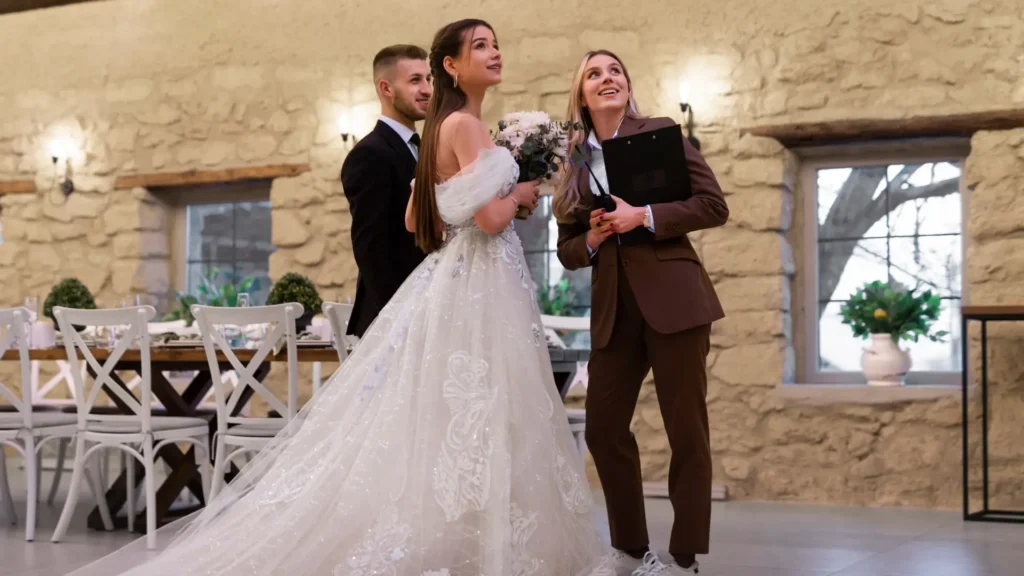Starting a wedding venue might sound like a dream — and in many ways, it is — but it’s also a serious business that demands strategic thinking, attention to detail, and a lot of patience. Whether you own property or are just beginning to explore the idea, opening a wedding venue isn’t just about having a pretty space. It’s about creating an experience that people want to pay for — and remember forever.
This guide isn’t your typical dry, textbook-style overview. It’s built on real-life considerations, actual industry insights, and the stuff most people don’t tell you upfront. If you’ve ever found yourself thinking, “Could I really open a wedding venue?” — this is for you.
Step 1: Clarify Your Vision — and Why You’re Doing This
Before diving into the logistics, take a moment to get clear on what you’re building — and why.
- Are you creating a high-end luxury experience or a rustic, down-to-earth escape?
- Will you host 10 weddings a year… or 100?
- Is this a passion project or a full-time business plan?
The most successful venue owners started with clarity. One of them, Rachel Sutton — who opened a vineyard-style wedding venue in Utah — says, “You need more than land. You need intention, style, and a strategy for how this fits into people’s dream day.”
Think about the couples you want to serve. Are they the DIY bride and groom, or do they want everything handled for them? Your answer affects everything from design to pricing.
Step 2: Pick the Right Location (or Make the Most of What You Have)
Let’s bust a myth: You don’t need to own a castle to open a wedding venue.
What you do need is:
- A setting people want to get married in (scenic views, charming buildings, or great ambiance)
- Enough space for ceremony, reception, parking, and vendors
- Flexibility to handle weather, noise, and logistics
If you already own land or a unique structure — an old barn, estate, vineyard, or lodge — you’ve got a head start. But even then, think about accessibility. Is it easy to find on GPS? Can vendors get in and out with trucks and gear?
Also, check out zoning regulations. Just because your space feels perfect doesn’t mean it’s legally ready for weddings.
Step 3: Research Local Laws, Zoning, and Noise Ordinances
This is where many first-timers get tripped up. Every county, city, and township has its own rules. Some places allow events freely, while others require a Conditional Use Permit (CUP) or restrict outdoor music past a certain hour.
Make time to meet with:
- City or county planning departments
- Fire marshal (especially for capacity and exits)
- Health department (if serving food or drinks)
- Local law enforcement (to understand curfews and noise complaints)
And yes — get insurance. A lot of it. This typically includes:
- General liability (for injuries and accidents)
- Liquor liability (especially for BYOB events)
- Property insurance (for damage or theft)
Many couples and vendors won’t even work with you unless you’re covered.
Step 4: Start Renovations with Function in Mind

Now comes the fun part: building your space.
But here’s the trick — don’t just focus on beauty. Focus on flow.
A wedding day is like a moving machine. Guests arrive. The bridal party gets ready. A ceremony happens. There’s food, dancing, and cleanup. The venue needs to support all of that seamlessly.
Things to consider:
- Where do people park?
- Is there a bridal suite or prep room?
- Do you need to add bathrooms or climate control?
- Is there a backup plan for rain or heat?
- Is there power access for DJs, caterers, and lighting?
One often-overlooked touch: good lighting. Both for ambiance and photography.
💡 Pro tip: Partner early with local photographers or planners. They’ll tell you exactly what clients love—and hate—in a space.
Step 5: Price for Profit, Not Just Popularity
It’s tempting to underprice yourself to attract bookings — but that can backfire fast.
Start by calculating all your fixed costs:
- Mortgage or lease payments
- Utilities and maintenance
- Staffing (cleaning, setup, coordination)
- Marketing and software subscriptions
- Insurance and taxes
Then estimate how many events you can realistically host per year. Divide your annual cost by that number to find your minimum sustainable rate.
Now, look at your competitors. Are they charging $4,000? $12,000? Somewhere in between?
Offer tiered packages:
- Venue-only rental
- Venue + basic coordination
- All-inclusive packages (for couples who want zero stress)
Transparent pricing and flexible options make your offer feel tailored—not transactional.
Step 6: Build Your Brand and Digital Presence
You can have the most stunning space in the world… but if no one can find it online, it won’t book.
Here’s what today’s couples look for:
- A mobile-friendly website with photos, FAQ, pricing, and contact info
- Social proof: Reviews on Google, The Knot, and WeddingWire
- Active Instagram and Pinterest accounts with styled shoots and behind-the-scenes videos
- Real wedding galleries showing how the space looks with different themes
Tip: Offer your venue for styled photo shoots with local vendors in exchange for professional images. It’s a fast way to build a portfolio and buzz.
Don’t skip Google My Business. Many bookings start with “wedding venue near me.” Be there.
Step 7: Network Like Your Calendar Depends on It (Because It Does)
Referrals will be your lifeblood in this business. Especially in your first year.
Start forming relationships with:
- Wedding planners
- Photographers
- Florists
- DJs
- Caterers
Offer them tours. List them as preferred vendors. Feature their work on your socials. It’s a win-win.
You should also consider:
- Hosting open houses for engaged couples
- Attending bridal expos or local networking events
- Running early bird or soft-launch pricing offers
Even consider having your first few weddings at a discounted rate — in exchange for testimonials, photos, and word-of-mouth marketing.
Real Talk: Common Mistakes First-Time Venue Owners Make
To help you stay ahead, here are a few pitfalls to avoid:
- Underestimating the timeline: It often takes 6–18 months from concept to launch.
- Ignoring weather: Have a rain plan, fans, heaters — something.
- Thinking “pretty” is enough: Logistics make or break the guest experience.
- Not vetting vendors: One bad caterer can sour a great day at your venue.
- Neglecting contracts: Always use clear terms and cancellation policies.
Bonus: Opening a Wedding Venue in Utah? Here’s Why It Works

Utah has quietly become one of the top emerging wedding destinations in the country. With its diverse landscapes, from red rock canyons to alpine meadows, plus a relatively affordable cost of living, it’s a goldmine for venue owners.
There’s a blend of local couples and destination weddings, especially in areas like:
- Salt Lake Valley
- Moab
- Provo and Utah County
- Park City
Combine that with Utah’s increasing wedding population (over 20,000 weddings per year, according to U.S. Census data), and you’ve got a recipe for long-term demand.
Final Thoughts: Is It Worth It?
Opening a wedding venue is not just about pretty flowers and first dances. It’s a business built on people’s most important day — and that comes with a unique kind of responsibility and reward.
You’ll be working weekends. You’ll manage emotions. But you’ll also create memories that last a lifetime.
If you’re willing to put in the work, align with good people, and learn from your clients, opening a wedding venue could become the most meaningful investment you ever make.


